Biology
 Amino acids can be linked together in any order to form a long chain - polypeptide.
Amino acids can be linked together in any order to form a long chain - polypeptide.
- Q: Compare And Contrast The Structure Of Collagen And Cellulose
The monomer of collagen is an amino acid whereas the monomer of cellulose is beta-glucose. The monomers in collagen are linked by peptide bonds whereas those of cellulose are beta (1,4)-glycosidic bonds. Collagen is an alpha helix polypeptide with a turn...
- The Acceptor Stem And Anticodon Are At Ends Of The Tertiary Structure
KEY CONCEPTS:The clover-leaf forms an L-shaped tertiary structure with the acceptor arm at one end and the anticodon arm at the other end. The secondary structure of each tRNA folds into a compact L-shaped tertiary structure in which the 3 end that binds...
- #16 Summary Of Biological Molecules
From small to large 1. The larger biological molecules are made from smaller molecules. Polysaccharides are made from monosaccharides, proteins from amino acids, nucleic acids from nucleotides, lipids from fatty acids and glycerol. 2. Polysaccharides,...
- #7.2 Biological Molecules - Syllabus 2016
2.1 Testing for biological molecules 2.2 Carbohydrates and lipids 2.3 Proteins and water This section introduces carbohydrates, proteins and lipids: organic molecules that are important in cells. Nucleic...
- #7.1 Biological Molecules - Syllabus 2015
? Structure of carbohydrates, lipids and proteins and their roles in living organisms ? Water and living organisms Learning Outcomes Candidates should be able to: (a) [PA] carry out tests for reducing and non-reducing sugars (including using colour...
Biology
#13. Protein - Primary, Secondary, Tertiary and Quaternary structure

Protein molecules can be made up of the same polypeptides or different polypeptides.
1. Primary structure: The sequence of amino acids in a polypeptide or protein molecule.
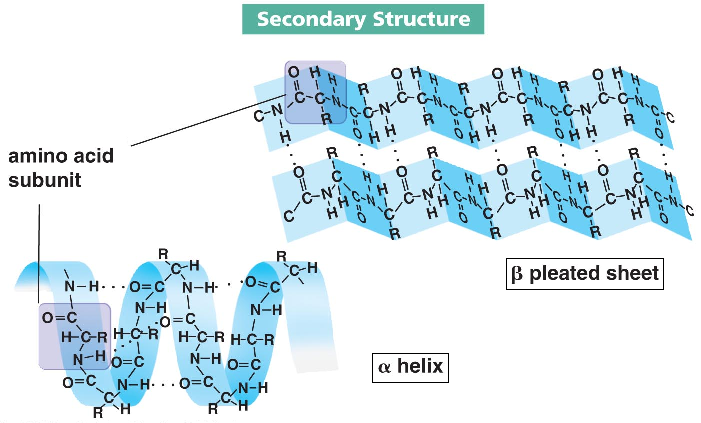
Tertiary structure is held by:
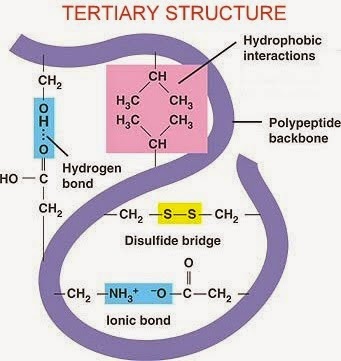
4. Quaternary structure: ? 2 polypeptide chains join together to form a protein.
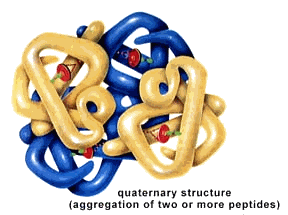
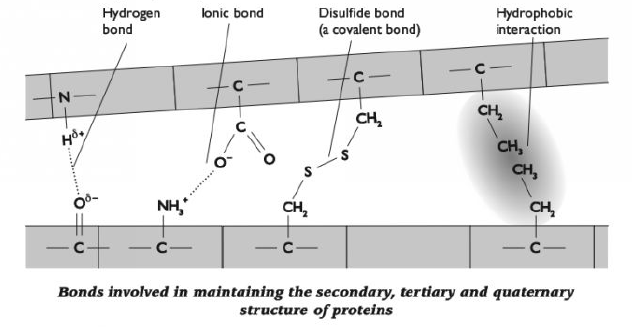
The tertiary and quaternary structures of a protein, and its properties, are determined by its primary structure.

1. Primary structure: The sequence of amino acids in a polypeptide or protein molecule.
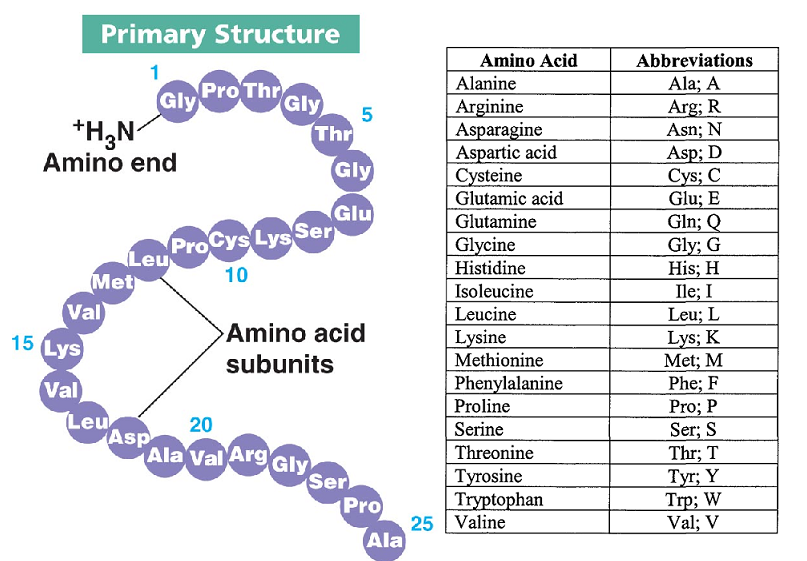 |
| The 3 letters in each circle are the first 3 letters of the amino acid. |
2. Secondary structure: The way in which the primary structure of a polypeptide chain folds.

- After synthesis, polypeptide chains are folded or pleated into different shapes: Alpha helix (regular 3D shape) and Beta-pleated sheet (twisted, pleated sheet)
- The helix is hold by many Hydrogen bonds between amino acids at different places in the chain, giving the shape great stability.
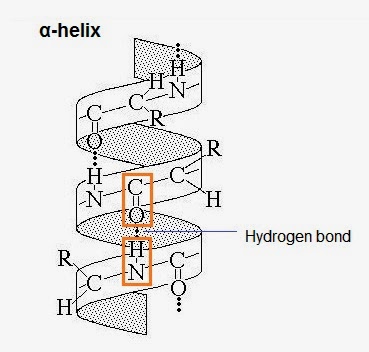 |
| The typical Alpha helix is about 11 amino acids long. |
3. Tertiary structure: The final 3D structure of a protein, involving coiling or pleating of the secondary structure.
 |
| Tertiary structure. |
- Hydrogen Bonds - formed between amino acids at different points in the chain.
- Disulphide Bonds - a strong double bond (S=S) formed between the Sulphur atoms within the Cysteine monomers.
- Ionic Bonds - formed between 2 oppositely charged 'R' groups (+ and -) found close to each other.
- Hydrophobic and Hydrophilic Interactions: amino acids may be hydrophobic or hydrophilic; in a water based environment, the hydrophobic parts of globular protein are orientated towards centre and the hydrophilic parts are towards edges.


- Some proteins are made up of multiple polypeptide chains, sometimes with an inorganic component (e.g. a haem group in haemoglogin) called a Prosthetic Group. These proteins will only be able to function if all subunits are present.
- The polypeptide chains are held by the same type of bonds as in the tertiary structure.


Additional sources: Some parts of the note are taken from A level Notes
| Syllabus 2015 (g) explain the meaning of the terms primary structure, secondary structure, tertiary structure and quaternary structure of proteins and describe the types of bonding (hydrogen, ionic, disulfide and hydrophobic interactions) that hold the molecule in shape; |
Syllabus 2016 b) explain the meaning of the terms primary structure, secondary structure, tertiary structure and quaternary structure of proteins and describe the types of bonding (hydrogen, ionic, disulfide and hydrophobic interactions) that hold these molecules in shape |
- Q: Compare And Contrast The Structure Of Collagen And Cellulose
The monomer of collagen is an amino acid whereas the monomer of cellulose is beta-glucose. The monomers in collagen are linked by peptide bonds whereas those of cellulose are beta (1,4)-glycosidic bonds. Collagen is an alpha helix polypeptide with a turn...
- The Acceptor Stem And Anticodon Are At Ends Of The Tertiary Structure
KEY CONCEPTS:The clover-leaf forms an L-shaped tertiary structure with the acceptor arm at one end and the anticodon arm at the other end. The secondary structure of each tRNA folds into a compact L-shaped tertiary structure in which the 3 end that binds...
- #16 Summary Of Biological Molecules
From small to large 1. The larger biological molecules are made from smaller molecules. Polysaccharides are made from monosaccharides, proteins from amino acids, nucleic acids from nucleotides, lipids from fatty acids and glycerol. 2. Polysaccharides,...
- #7.2 Biological Molecules - Syllabus 2016
2.1 Testing for biological molecules 2.2 Carbohydrates and lipids 2.3 Proteins and water This section introduces carbohydrates, proteins and lipids: organic molecules that are important in cells. Nucleic...
- #7.1 Biological Molecules - Syllabus 2015
? Structure of carbohydrates, lipids and proteins and their roles in living organisms ? Water and living organisms Learning Outcomes Candidates should be able to: (a) [PA] carry out tests for reducing and non-reducing sugars (including using colour...
